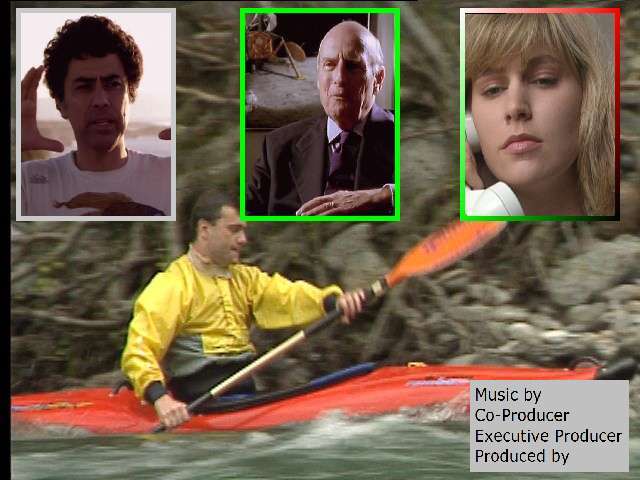"Picture In Picture" operation
CONTENT
- What is a "Picture In Picture"?
- "Picture In Picture" in Breeze
- "Picture In Picture" in "View" and "Play" modes
- "Picture In Picture" video editing
- Example of PIP video editing - learn it "step by step"
- Download source and processed video data for "step by step" example
What is a "Picture InPicture"?
Term "Picture In Picture" designates image, video sequence or image operation where resulting image or video sequence is assembled of two or more images or video sequences. One of those images / video sequences is called a “base”: base image or base video sequences. Other images and video sequences are called “insertion”: inserted image or inserted video sequence (see Figure 1).Figure 1.

Picture In Picture" in Breeze
In Breeze "Picture In Picture" can be used in all modes: "View" / "Slide Show", "Play" / "Replay", "Edit", "Convert".Base "Picture In Picture" image can be taken from any of 4 available video ports and displayed in any video panel, primary or assistant.
Similarly, inserted "Picture In Picture" image can also be taken from any of 4 available video ports and displayed in any video panel, primary or assistant.
If video port is receiving data from the stopped or paused channel then displayed picture is static (presents no motion). If video port is receiving data from the playing channel then displayed picture is dynamic (presents video motion).
Inserted picture may present the whole source image where it is taken from or may be cropped of it, so it will be just a part of source image. Size of the image inserted into the base picture can also be adjusted.
Parameters of PIP operations can be set in the in the options dialog "Picture In Picture". It is accessed via the "Tools" menu or directly via the "PIP (Picture In Picture) Options..." command in the "View" menu.
Turning On and Off PIP operations can be done in the options dialog "Picture In Picture" . But a faster way to do that is to use buttons "Enable/Disable 'Picture In Picture" buttons in the "View" toolbar or in the "View" menu.
"Picture In Picture" in "View" and "Play" modes
2 streams of video data can be merged into PIP image in a number of variants. As static picture in static, static in dynamic, dynamic in static, dynamic in dynamic. From any of 4 video ports available, in any combinations. Video stream played forward can be inserted as PIP into the base video stream played forward, or backward in forward, forward in backward, backward in backward. Etc.PIP images can be captured on the "fly" in "View" (graphics) and "Play" (video playback) modes
Any video panel can be captured "As is", as PIP, and saved to the file instantly by clicking buttons in the "Channel" tool bar or "Channel" menu. Video data from the playing / replaying video channels can be saved to the file as PIP video sequence. Images captured from the channels with buttons "Get" in the control panel can be displayed as PIP instantly. Images copied from the different video ports or external applications can be pasted instantly to any video port and instantly displayed or saved as PIP. Any text prepared in the external applications and converted into MS bitmap format, can be pasted to any video port and instantly merged into the PIP.
2 streams of video sequences can be merged and save to the file as a "Picture In Picture". PIP video streams can be save to the external file or files in a number of formats. Video data saved to the file(s) during playback of primary / assistant channel may correspond to the video data in the primary / assistant video panel "As is", or be built on the base of video data from the channel itself.
"Picture In Picture" video editing
All mentioned above capabilities can be used for multi pass layered "Picture In Picture" assembling of video sequences. Saving merged from 2 streams PIP video sequences to the file can be repeated sequentially with different PIP configuration setting and different source streams. It allows editing and assembling rather complex multi layered PIP video sequences. (see Figure 2).Figure 2.

Sequential layers of images are gradually assembled in the required Z-order (vertical order). Inserted images can be placed in the different areas of base image, can be nested within each other, or can overlapped.
At the Figure 3 you may see an example of the image from the video sequence assembled as a layered "Picture In Picture".
Figure 3.

Finally assembled image (video sequence) consists of 8 individual images. In total it required 7 cycles of merging images into the "Picture In Picture".
In general there are two main ways to assemble multi part PIP image or video sequence. It can be done pure sequentially or sequentially-parallel.
In pure sequential method every new inserted image is laid out on the top of the previously made PIP image.
In sequentially-parallel method, at the first stage some closely related to each other images are assembled into the PIP sub groups. Then, at the second stage, already grouped PIP images are assembled into the final PIP image (video sequence).
For example, at the shown above picture (Figure 3), 3 images of talking persons were inserted at the first stage into the frames. Then framed images were sequentially inserted into the base picture.
Example of PIP video editing - learn it "step by step"
More detailed description of "Picture In Picture" video editing you may find at the Breeze support web site at the www.DiscoveryBiz.net.On-line "Picture In Picture" HTML help can be found in the section "Frequently Asked Questions" .
"Picture In Picture Guide" in *.pdf format can be found in the section "Documentaion"

